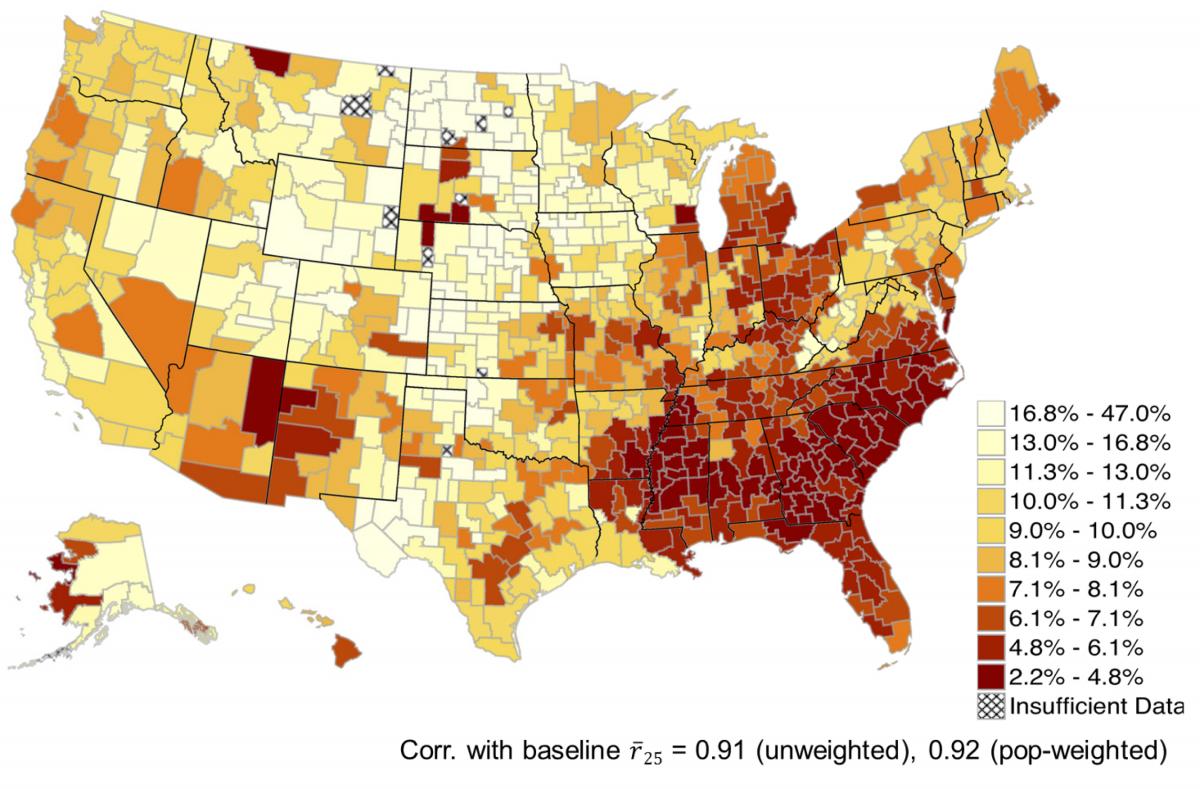Data Shows More Needs to be Done to Bring Widespread Prosperity to the South
SECF is partnering with the Council on Foundations to promote the first Inclusive Economic Prosperity Convening in the South, May 23-24, hosted by The Spartanburg County Foundation. We hope you will join us for this important convening of foundation staff and trustees to learn how philanthropy can be a driving force that advances economic prosperity for all. Register today!
While economic disparities in the U.S. are widespread, nowhere in the country is the gap in economic mobility more pronounced than the South. Just look at the map below and you’ll notice the broad swath of red indicating the lack of upward mobility in the region. Raj Chetty and a team of researchers from Stanford, Harvard, and Berkeley used data from the most-recent Census and tax returns to chart the chance a child born into the bottom fifth income bracket could reach the top fifth by adulthood.

From a list of 741 commuting zones, four Southern cities were ranked in the bottom ten in terms of upward mobility. These were Atlanta, Charlotte, Jacksonville, and Raleigh, all of which have shown indicators of strong economic growth. The chances of a child going from the bottom quintile to the top in these cities were some of the lowest in the country—nowhere higher than 5 percent. By contrast, the leading cities in upward mobility—New York, Boston, San Francisco, Seattle, to name a few—all measured 10 percent or higher.
But is it just geographic differences that are to blame for the lack of economic mobility in the South? In addition to location, Chetty and his fellow researchers found that another primary factor in upward mobility was an individual’s racial identity. The latest research from the Equality of Opportunity Project finds that in 99 percent of Census tracts in the United States, black boys earn less in adulthood than white boys who grew up in families with comparable income. This suggests that differences in resources at the neighborhood level, such as access to quality schools, cannot by themselves explain the intergenerational gaps between black and white children.
Chetty and his colleagues identified several key factors that could make a place more likely to experience low levels of upward mobility. Areas with low mobility tended to be racially segregated, have a higher poverty rate than the national average, a higher share of single mothers, and lower degrees of social capital. These are all characteristics that are prevalent in our region. The South is home to the largest share of the black population in the U.S. and many communities are even more segregated now than they were 60 years ago. Every state in the Southeast, except Virginia, has a poverty rate above the U.S. average and ranks in the bottom half of states by child well-being.
Despite these ominous statistics, there is a path forward. In the latest Business Case for Racial Equity report from the W.K. Kellogg Foundation, the authors state that “by 2050, our country stands to realize an $8 trillion gain in GDP by closing the U.S. racial equity gap.” To do so would require us to address health disparities, create more affordable housing, improve access to education, reform our criminal justice system, and provide better opportunities for entrepreneurship and employment. Given the policy barriers set in place over the past several decades and the complicated nature of each of these issue areas, any progress is going to require a concerted effort at systems change.
This is certainly a daunting undertaking, but there have been notable successes from foundation-sponsored initiatives in the region. Philanthropy as the South’s Passing Gear: Fulfilling the Promise, a report commissioned by SECF and written by MDC (formerly Manpower Development Corp.), highlights seven case studies of funders using their capital to address the root causes of inequities in their respective communities. Since 2008, the Duke Endowment has partnered with a number of other funders to expand the Nurse-Family Partnership in the Carolinas, reducing the risk of child neglect and improving outcomes for children born into low-income families. The Mary Reynolds Babcock Foundation has invested in community development financial institutions (CDFIs) throughout the South to provide access to capital for low-income individuals, which has led to growth in small business development and greater homeownership in underserved communities. In upstate South Carolina, the Spartanburg County Foundation is utilizing a collective-impact model toward achievement of an ambitious goal that 40 percent of county residents ages 25 and above will have a bachelor’s degree by 2030.
The South is currently the fastest growing region in the United States and its population will change dramatically in the next 20-30 years. While 77 percent of Southerners age 75 or older identify as white, more than half of the region’s children under 15 are non-white. For the South to prosper and grow in the years to come, we must work toward an inclusive economy that benefits all.

